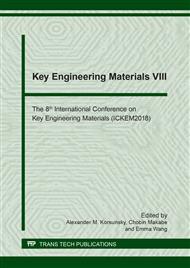p.499
p.506
p.517
p.524
p.531
p.536
p.542
p.547
p.554
Semi-Analytical or Inverse Identification of Yoshida-Uemori Hardening Model
Abstract:
The Yoshida-Uemori combined kinematic and isotropic hardening model is widely applied to numerical prediction of spring-back during sheet metal forming process. With the experimental plastic behavior of aluminum alloy AA5182-O sheet under single cyclic loading, the semi-analytical method was presented to calibrate the parameters of Yoshida-Uemori hardening model. Meanwhile, an inverse identification method was suggested by parameter optimization for minimizing the error between the experimental and predicted results. By comparing the two methods, the Yoshida-Uemori hardening model identified by inverse method is found to be more accurate for description of the Bauschinger effect than the one identified by semi-analytical method, especially for transient softening phenomenon.
Info:
Periodical:
Pages:
531-535
Citation:
Online since:
August 2018
Authors:
Price:
Сopyright:
© 2018 Trans Tech Publications Ltd. All Rights Reserved
Share:
Citation:


